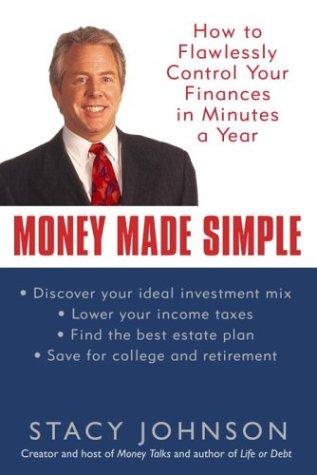Money Made Simple is a book that covers nearly every area of personal finance. This book was one of the most applicable personal finance books I have read. The lessons taught in the book were easy to apply and fairly conservative. The table of contents of Money Talks is as follows:
- A Tale of Two Pities
- Understanding Investments, Once and for All
- The Only Chapter of a Book About Investing in Stocks You'll Ever See Whose Title is Longer than the Information It Gives
- Buying Stocks the Right Way: Mutual Funds
- Bonds
- Stupid Investment Tricks I: Futures and Options
- Stupid Investment Tricks II: Other Stuff
- Dividing Up the Dough: Asset Allocation
- The Only Investment System You'll Ever Need
- Investing for Retirement
- Investing for College
- Deflating Inflation
- Setting Goals
- Getting Organized
- Making Your Life Less Taxing: Income Taxes
- Insurance
- Real Estate
- Estate Planning
- Bring It All Together
I do not have enough time to write about every chapter in this book, so I am going to highlight some of my favorite information in Money Made Simple.
- Stacy Johnson gives a very simple, but effective way of dividing up your savings. First take 100 minus your age (this is the percent of your savings that should be in the stock market). Next divide up the remaining percentage equally between cash and bonds. In my example, 100-23=77% in stocks, 11.5% in bonds, and 11.5% in an interest bearing savings account.
- According to Money Talks, dollar cost averaging (investing fixed amounts of money at regular intervals over periods of time), is the only investment system you will ever need. By investing this way, you'll find that you can create wealth even if your investment does not increase in value over time. Just set up an index fund and invest a set amount at the same time every month. Simple, but effective.
- Stacy Johnson recommends buying stocks in the form of index funds. One of the best index funds is the Vanguard 500 Index Fund (VTSMX). This fund has an expense ratio of only .18% compared to an industry average of 1.12%. The fund does not have a front-end load fee. Vanguard also has a Total Bond Market Index Fund (VBMFX), a Total International Stock Index Fund (VGTSX), and a Prime Money Market Fund (VMMXX).
- The last thing I would like to highlight is the getting organized chapter. Stacy Johnson highly recommends getting all of your important paper work together and organizing it in one central place. When a disaster happens, the last thing you want to be doing is searching for your insurance plans. Courtney and I recently organized all of our important paperwork into a three-ring binder. It has already proved to be beneficial. It takes time, but it will save time down the road.
I would highly recommend this book to people in all stages of life. Reading this book can help anyone get started organizing their finances. There is a variety of topics covered in the book and all will apply to your life at some point.


No comments:
Post a Comment